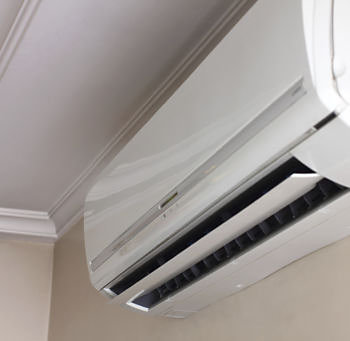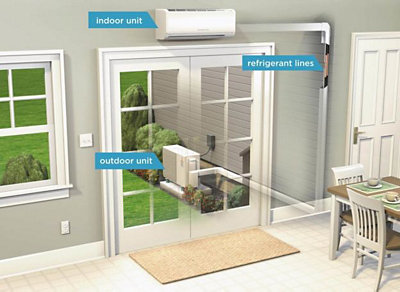How Much Does It Cost To Install A Ductless Mini-split AC In Florida?

March 19, 2018
Ductless mini-split air conditioners are an excellent cooling option for homes that don’t have ductwork. But how much does it cost to install one?
Well, the cost to install a ductless mini-split AC in Florida ranges from $3,000 to $7,000+.
The price that you’ll end up paying will all depend on 2 things:
- The specifications of your ductless unit(s)
- The labor required to install the unit(s)
Let’s breakdown these two aspects above to help you determine how much you could pay for your ductless mini split AC installation.
Need a professional estimate for your mini-split installation? Just contact us online or by phone and we'll send a tech over immediately to inspect your home, chat about your cooling needs then offer a fair quote.
The specifications of your ductless unit(s)
Three factors affect the price that you’ll pay for the ductless unit itself (not including labor for installation):
Factor #1: How many units you’ll need
The more ductless units you need to cool your home, the higher the overall installation price.
A ductless unit has 3 basic parts:
- Outdoor unit (the “condenser”)
- Conduit (refrigerant and electrical lines that attach the outdoor unit to the indoor unit—seen below as “refrigerant lines”)
- Indoor unit (the “evaporator”—this part blows cold air into your home)

Source: Energystar.gov
A ductless system’s indoor unit is designed to only cool one room/area. So, if you have more than one room that you need to cool, you’ll need to invest in more than one indoor unit (i.e. “evaporator”), which increases the upfront cost.
The good news? You can typically install up to 4 indoor units to every 1 outdoor unit (when we refer to one ductless “unit”, we’re referring to a system with one condenser and up to 4 evaporators).
Factor #2: BTU output
The higher the “BTU output” of your ductless unit(s), the higher the overall price of the installation.
So, what exactly does BTU output mean? To put it simply, the BTU output of an AC measures the amount of cool air the unit can put out in one hour.
So, the BTU you would need really all depends on the size of the room/area that its cooling (remember that one ductless indoor unit only provides cooling for one area—unlike how a central AC indoor unit can cool an entire home).
But the size of the room isn’t the only factor that determines the BTU output you’d need. In fact, a handful of other factors determine ductless AC sizing, including:
- Number of windows the room has
- Number of doors the room has
- Whether the room is a kitchen space or is close to the kitchen
- How much direct sunlight the room gets?
- How well insulated the room is?
- The height of the ceilings
- Number/type of lightbulbs in the room
- The usual # of occupants in the room
- Whether the room has carpet or hardwood
The only way to get an accurate BTU measurement is to have a tech perform a “heat load calculation”. This calculation looks at all the factors above (and more) and matches the room with the accurate BTU output.
To learn more about heat load calculations and AC sizing, check out our blog, “How Do I Know What Size Air Conditioner I Need for My Home?”.
Factor #3: SEER rating
The higher the SEER rating of your ductless unit, the higher its overall price but the lower your monthly energy bills.
Every ductless unit has a SEER (Seasonal Energy Efficiency Rating) that falls anywhere between 13 and 21. This rating basically tells you how much cooling the unit provides compared to the amount of electricity it consumes.
Put simply, the higher the SEER, the less energy it consumes, which means the lower your monthly energy bills will be.
So, what SEER should you get?
Well, it depends:
- Willing to spend more upfront? We suggest getting a 16+ SEER for even lower monthly energy bills.
- On a budget? We suggest getting a 13-SEER unit (13 is the federal minimum SEER for ductless units).
Still stuck on SEER options? Check out our in-depth SEER suggestions in our blog, “What’s a Good SEER Rating for My New AC in Florida?”.
The labor required to install the unit(s)
In regards to labor, 3 factors affect the overall price to install a ductless system:
Factor #1: How many units you’ll need
The more ductless units you need to cool your home, the more labor required for the job, which raises the overall price.
Remember, though, that one outdoor unit (condenser) can basically cool 4 rooms. So, if you need to cool 4 or fewer rooms, you’ll save money since your tech will only need to install one outdoor unit.
Need to cool 5 or more rooms/areas? Then you’ll need to have more than one outdoor unit installed, which means higher labor costs.
- Let’s take a look at just some of the tasks your tech will need to complete during a typical ductless installation:
- Pouring/leveling concrete pad
- Setup of refrigerant
- Installing dedicated 240V outlet/circuit
- Connecting and insulating the conduit lines to each evaporator
- Charging the outdoor unit with refrigerant (the special substance that absorbs heat from your home)
- Creating the “pass through” hole where conduit lines feed into the indoor evaporator units (usually a 3-inch hole)
- Mounting each evaporator unit on indoor walls
- Cleaning up area/materials
Factor #2: Material of the home
If your home is made of delicate material (i.e. stucco), expect higher labor costs.
Why? Well, homes made of more durable materials (wood framing, plywood, vinyl or metal siding) make it easier to create a “pass through” hole for the ductless unit’s “conduit” (refrigerant and electrical lines). If your home is made of these durable materials, the tech should be able to create this hole themselves.
Sometimes, though, if the home is made of sensitive materials like logs or stucco, a carpenter may need to create the 3-inch “pass through” holes. If this is the case, the overall installation price may increase.
Factor #3: Electrical requirements
Expect higher labor costs if your home doesn’t already have the appropriate electrical capacity, outlets or circuits to power your ductless unit.
A typical ductless unit requires:
- A 110-volt or 220-volt outlet (220-volt outlets need for units over 12,000 BTU)
- A dedicated dual pole 20-amp circuit breaker
If your main electrical panel doesn’t have the capacity to power an extra dedicated 20-amp circuit, you may need to upgrade your electrical panel.
Need a ductless AC installation estimate from a Florida HVAC tech?
Just contact us and we’ll send out a professional AC technician who will inspect your home, ask you about your cooling needs and offer a fair quote. We serve communities in Central and Southwest Florida including Sarasota, Tampa, Orlando, Naples and more.